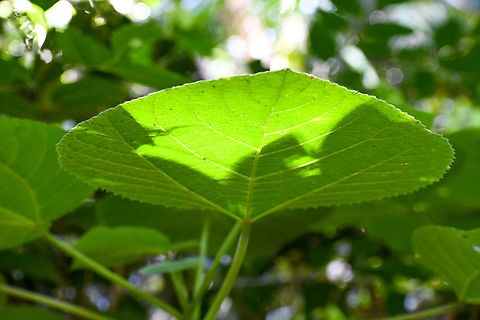
Appearance
"D. moroides" is a straggly perennial understory shrub, usually flowering and fruiting when less than 3 m tall, but it may reach up to 10 m in height. It is superficially similar to "Dendrocnide cordifolia", with the most obvious difference being the point of attachment of the petiole to the leaf blade—where "D. moroides" is peltate, i.e. the stalk attaches to the underside of the leaf and not at the edge, "D. cordifolia" is cordate. The stem, branches, petioles, leaves, and fruits are all covered in stinging hairs.It has large, heart-shaped, simple leaves about 12–22 cm long and 11–18 cm wide with toothed margins, a pointed tip and a cordate to obtuse base shape. There are six to eight pairs of lateral veins either side of the midrib. The petiole is quite long, about as long as the leaf blade itself, with stipules around 1–2 cm long.
The inflorescence is monoecious, and is borne in the leaf axils. It is up to 15 cm long, often paired. It carries both male and female flowers which are quite small, the perianth measuring less than 1 cm across. Flowering occurs throughout the year, but mostly in summer.
Fruits of this species are an achene, produced in number in a globular structure which is pink to light-purple in colour and has an appearance similar to a mulberry. Each achene, measuring just 2 mm long, is contained in a small fleshy sac which derives from the swollen pedicel. As with the rest of this plant, the infructescences are also covered in stinging hairs, but are edible if the hairs are removed.
Naming
The common name gympie-gympie comes from the language of the indigenous Gubbi Gubbi people of south-eastern Queensland.Distribution
The species occurs in and near rainforest, from Cape York Peninsula south to northern New South Wales in Australia and also occurs in the Moluccas and Indonesia. It is an early coloniser in rainforest gaps, such as alongside water courses and roads, around tree falls, and in man-made clearings. The seeds germinate in full sunlight after soil disturbance. Although common in Queensland, it is rare in the southernmost part of its range and is listed as an endangered species in New South Wales.Habitat
"Dendrocnide moroides" serves as the host plant for larvae of the white nymph butterfly. A variety of insects feed on the leaves, among them the nocturnal beetle "Prasyptera mastersi" and the moth "Prorodes mimica", as well as the herbivorous Red-legged pademelon, which is unique among mammals in being apparently immune to the plant's neurotoxins. Fruits are eaten by various birds that distribute the seeds in their droppings.Defense
"D. moroides" is notorious for its extremely painful sting which may leave victims suffering for weeks or even months. It is reputed to be the most venomous plant in Australia, if not the world. After contact with the plant the victim will feel an immediate severe burning and stinging at the site of contact, which then intensifies further over the next 20 to 30 minutes and will last from hours to several days before subsiding. During this time they may get little sleep due to the intensity of the pain. In severe cases it may cause urticaria, and the lymph glands under the arms may swell and become painful, and there have been rare cases of hospitalisation.References:
Some text fragments are auto parsed from Wikipedia.